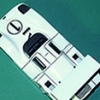Originally posted by Philip Whiteman
I also met in the mid 1980s a young development engineer at Cosworth (Paul ?) who was building a hillclimb car with a Lysholm (sp?) screw compressor. A couple of years later I learned to my horror that he had died from some rare blood disorder.
I know it's a couple of years late, but the "Paul" was Paul Squires. He developed a very effective 1100 class racer with fellow Cosworth employee Phil Kidsley, based on an older Brabham F3 chassis (?BT28? - I'm sure the Brabham guru's can correct me!), always immaculately turned out, fitted with a screaming short-stroke Cosworth BDJ (?BDH?) with the Lysholm blower. Initially the car ran with a full 1100cc displacement, since at the time hillclimbing did not penalise forced induction. After a year or two of running the car (allegedly producing over 200 hp!), the regs changed to 1.4 equivalency, so the interpid duo reworked the car with an even tinier version of the engine (785cc) with a more advanced blower arrangement which featured modified parts from the Cosworth V6 turbo F1 engine. IIRC, this engine was even louder than the earlier version (this was just before the mandatory silencers for speed events!), and I think still they managed to run competitively - both were very capable drivers with a good measure of bravery, and typically placed 1st and 2nd in class, often only a few hudredths of a second apart.
Commentators often referred to them as the "Squidsley" team, so closely matched were they.
I also heard the sad news about Paul's passing, but since emigrating I have somewhat lost touch with the fate of the car or Phil Kidsley.
On the topic of the thread, this car was most certainly innovative in the Bolster style, despite the fairly conventional chassis - I think it was granted acceptance as a "Shelsley Special" based on the MAC's time-honoured requirements (maybe Toby Moody can confirm this?)
Thanks for the memory jogger, Philip!

























